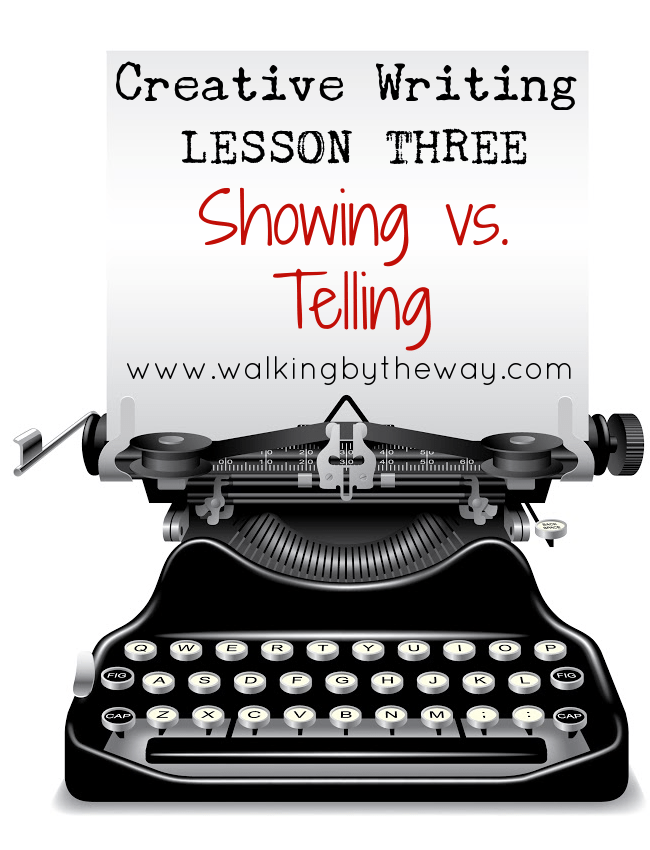
Showing vs. Telling in Writing
In this third creative writing lesson, I used the Showing vs. Telling lesson plan to teach my students the difference between the two.
A good writer doesn’t create a great tale by telling.
A good writer grabs his blank paper canvas and dips his paintbrush in red, blue, and yellow. He swishes his paintbrush on the paper. When he is finished, his reader can see images, actions, and places.
A good writer shows.
Showing vs. Telling Lesson Plan
Use this Showing vs. Telling lesson to plan to help your students learn the difference between the two.
1. We discussed some of the homework assignments from week one. One of my favorite things to do is to highlight a few homework assignments– mentioning what’s great, why it’s great, and what’s not so great.
As a class, we discuss how the writer could make her writing better. I ask questions to facilitate these discussions.
2. Wimpy and Wonderful Words
I highlighted boring words from their last homework assignments and banned them from using these words (in excess). Students recorded their personal banned words on the “Wimpy Words” hand-out.
We discussed ten additional overused words, and I banned the entire class from using these. Typically, I use qualifiers: very, much, a lot, little, pretty, etc. You can ban phrases, too (I think).
I kept right on blabbing about the variety of wonderful words we have in our language. I mentioned that each word carries baggage–like a little hobo sack right on its back! You have to find the right word and use it at the right (or the write) time.
I gave each student the Wonderful Words worksheets. As a class, we brainstormed eight different words for “said,” and students recorded them on the chart. The other words (ate, sleep, etc.) were assigned as homework; students were encouraged to bust out thesauruses to get the job done.
3. Introduction to Showing vs. Telling
Telling states something. The writer summarizes his experience.
Contrarily, showing uses description and action to throw a reader into a story.
To illustrate my point, I used examples from one of the books I was reading, The Mysterious Benedict Society and the Prisoner’s Dilemma. (Yes, I’m super-intellectual like that.) You can use examples from a book you love, or a book you are currently reading. Quality books are full of showing.
4. Showing vs. Telling Example
We looked at the telling story (from the printable pack):
“Once upon a time there was a girl. She was three years old. Her brother bothered her. She got very mad.”
I referred back to our definition of telling. Everything in this story is stating something. It’s a summary. Where is the description? Where are the sensory details? Let’s admit it: this story is boring.
This activity page has three boxes on it. I instructed the students to SHOW three things in the boxes.
- First Box: Show “three years old”
- Second box: Show “her brother bothered her”
- Third box: Show “she got very mad”
I reminded my students to think in images. Think in pictures. When I say, “three years old,” what do you picture in your mind? When I say, “her brother bothered her,” what do you picture? What would happen in a movie if a brother was annoying a sister? When I say, “she got very mad,” consider what mad looks like. Think in pictures.
Students worked through this in class. They read their answers in class and we discussed what worked and what needed a little more description.
This simple activity produces a lightbulb moment for students.
4. Showing with Pictures
To cement the showing concept, I gave each student a feeling word (confused, embarrassed, silly, lazy, sick, etc.), a large piece of paper, crayons, and markers. I asked them to draw a person exhibiting the word then to add phrases explaining the details drawn on the person.
Showing Example for Embarrassed
The students added these words: crying, pink complexion, wide eyes, red cheeks, blushing, open mouth, covering mouth with hand, and pounding heart.

Showing Example for Sick
The students added these words: dark circles under eyes, puffy ice pack, high fever, stern eyebrows, and blotchy face.

After this activity I reminded my students to draw pictures with their words (and not just with their crayons).
Writers wield words to wield power.
5. I gave students their assignment sheets for the week. Thankfully, no one shrieked, screamed, or punched me in the face as I explained what would be required for homework.
Creative Writing Lesson Printables for Showing vs. Telling
If you’d like a copy of the printables I used for this creative writing lesson, simply click on the image below.
It includes the homework, Wimpy Words activity page, Wonderful Words worksheets, Showing vs. Telling example story, and the Showing vs. Telling scenarios.
More Creative Writing Lessons
If you are looking for additional creative writing lessons, try these:


[…] mastered metaphor, studied sensory details, and improved our ability to show. In Week 4, students learned to capture images. We had some poetic moments. I love poetic […]